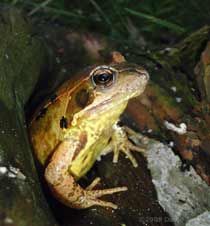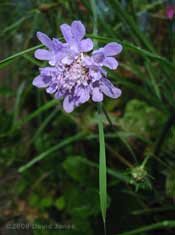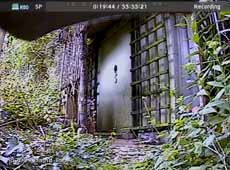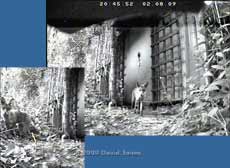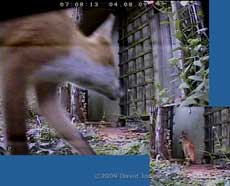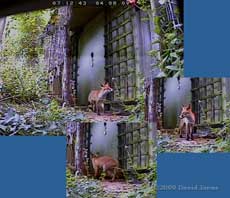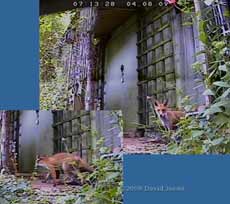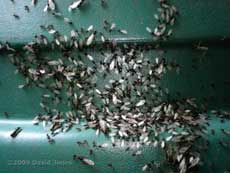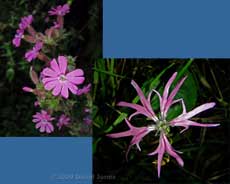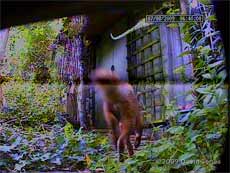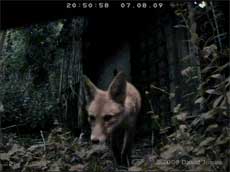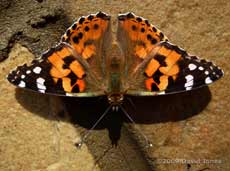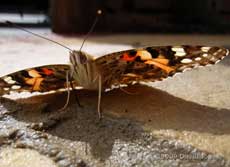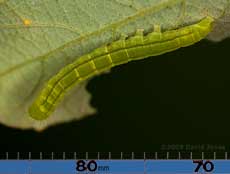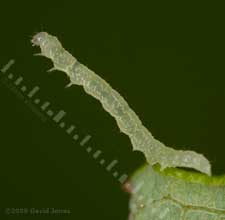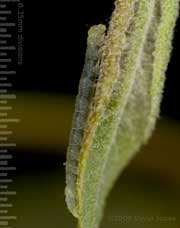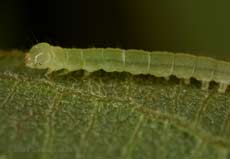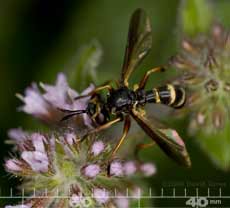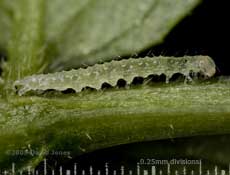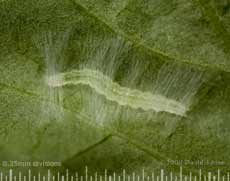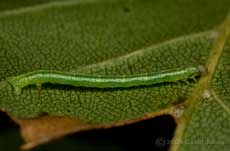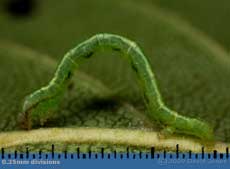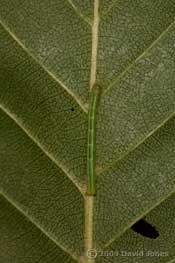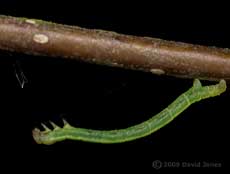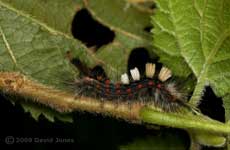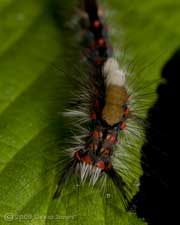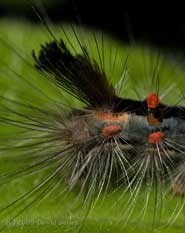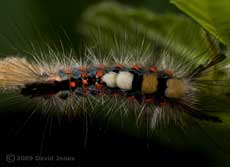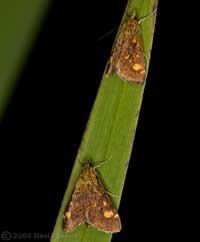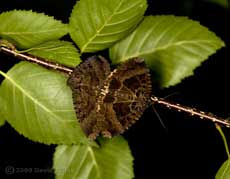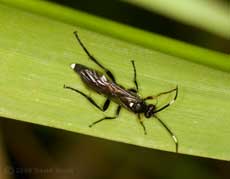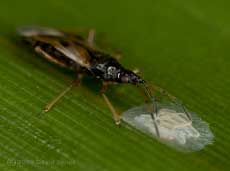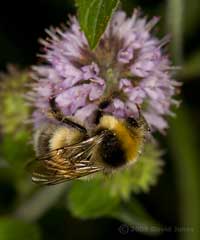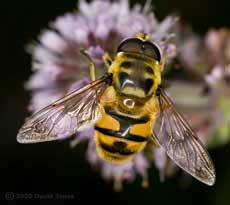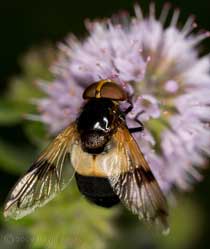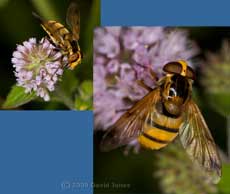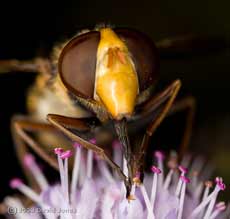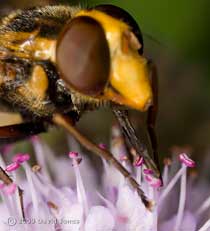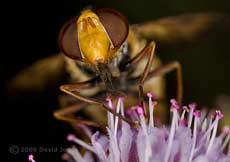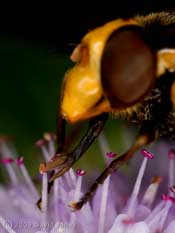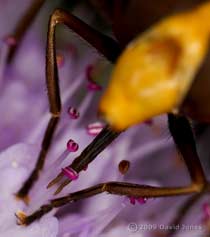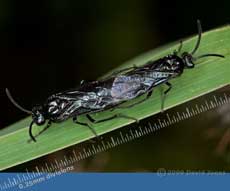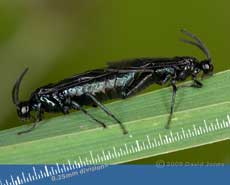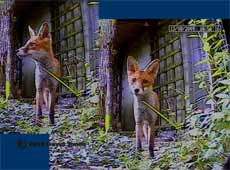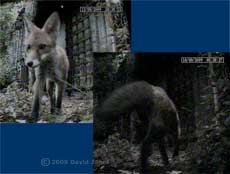Go to the last entry on this page .....Go to previous entry2 August - Well, the month has started with two very different days.
Yesterday was glum and damp from beginning to end, probably only enjoyed by the frogs!
Having said that, there was a new bit of colour in the garden after the first of the Small Scabious flowers opened.
Today the weather has been bright and sunny, and the temperature excelled, passing 21C in the afternoon! The insects have been busy, and I have seen Speckled Wood, Large White, Gatekeeper and Painted Lady Butterflies here today - no Peacocks as yet. Despite the conditions, I've not been taking photographs in the garden today because I've needed to get some jobs done, including setting up a cctv camera trap for our fox.
It is also possible to go round the shed by turning right before the lattice panel, and I'm hoping to establish which route the fox takes.
I've set up an infra-red lamp to illuminate part of the area covered by the camera, although I need to wait until it's dark to see how well this camera performs in IR light. By the middle of the week I hope to have an enclosed black and white camera which should perform better, should this colour camera prove to be of limited use at night. My doubts about this camera have been confirmed. By 9.15pm the image was more or less black, despite the IR lighting. However, at 8.45pm the reason for putting it out was revealed as a fox trotted out from behind the shed. It spotted the camera, despite it being hidden under a flower pot, and stopped, moved off towards the Birch tree, and stopped to take another look before disappearing. Notice how, despite the apparent brightness of the image, the colour had already disappeared by this time.
4 August - After a very pleasant summer's day yesterday, today we are back to overcast skies and dampness. I spent some of yesterday pruning some of the Hawthorn, and I intend to do a bit more today.
I didn't record any fox activity yesterday, but the recorder was running when it returned to its hiding place this morning. It first appeared at 7.08am and trotted straight past the camera and the shed door as it heading for its den.
A couple of minutes later it reappeared briefly, took a look around and returned back behind the shed.
Finally, as if to confirm that its den is also accessible from both directions, it appeared from between the two shed, and took a last look around before disappearing again. These images suggest that it is a healthy individual, and it will be interesting to follow its comings and going through the rest of the year. Is it really alone?
The video clip of that sequence was a resounding success a bit later in the morning when my little grand-daughter came to visit. Erin especially liked it when the fox seemed to look straight at her, and when it peeped around the corner right at the end - that had to be repeated numerous times! As soon as she arrived she wanted to go down the garden, and before she left, she spent the best part of five minutes sitting on the table on our veranda, waiting birds to appear. It's great the way she keeps very quiet and tilts her head to listen to their twittering in the Hawthorn - not bad for a one year old... At just before 6pm I took some kitchen scraps to the composting bin and found this group of ants, including queens and winged males, on the side of the bin. The temperature this afternoon got near to 23C, and it felt quite humid. However, while some of the cloud looked quite threatening, there has been no rain since this morning. By 8pm the entire group had moved around to the shaded side of the bin, with no sign of any flying away. I didn't mention it at the time, but four days ago, when I took the lid off the bin there was a large group of winged ants present, but they vanished again, until today.
When I went to check on the ants at 8pm I spotted a flower that I thought had finished a month or so ago - a Ragged Robin, on a plant no more than six inches tall. While that is just a single bloom, the Red Campions are also having a revival, but this is expected, and there are numerous of their flowers open.
7 August - After another period of damp weather, today the clouds parted and we had a bright and sunny afternoon and evening. The flying ants pictured above had flown by the following morning, and could be found all over the garden - the spiders had a good breakfast! I've had a few technical problems with the fox camera. A replacement power supply seems to have helped it to give a more stable image, but with its poor low light performance it is still missing fox movements after dark, even with some IR lighting.
Today, the fox returned at 6.40am. The banding in this picture was due to the rejected power supply.
Yesterday we had numerous showers and the occasional bright spells. During one of those I had to go out, but my departure was delayed by the antics of a Painted Lady butterfly outside the front of the house.
It wasn't just sunbathing, but also taking advantage of the damp stone paving to gather minerals leaching out of the stones to supplement its nectar diet. I understand that this behaviour is called puddling.
9 August - weekend blessed with good weather, and I took advantage of it yesterday to get more of the Hawthorn trimmed. There's just one more section I can reach from our garden, but as usual that is going to have to wait until I build up the energy reserves again. Today it's been largely a day of rest, with visits from some of our family. Back on 30 July I trimmed our Willow and found (and photographed) butterfly or moth eggs on some leaves, as well as a small caterpillar about 1cm long. I kept the twig from that day, standing in a jar of water, and today I took another look at it.
First, it appears that the caterpillar has grown, and this afternoon I found this individual on the twig. I need to do a bit of searching to find its ID.
Also, all four eggs have disappeared. Instead I found four small, caterpillars. This is the smallest.
Two were very pale, but this one looked darker, although I think that was due to the material that it had been eating.
The fourth was just slightly larger, and had a bit of a green tinge about it. It also had markings that suggest that it is possibly the same species as the large caterpillar.
I've cut more twigs off the Willow to make sure that the caterpillars have sufficient food supplies, and I'll check on them again in the next couple of days. Down by the big pond the mint's flowering in coming along slowly, and the flowers are very popular with insects. It seems that the most numerous visitors are Greenbottles, followed closely by numerous species of hoverfly.
I now think that it is a conopid fly (member of the Conopidae family), and is possibly Conops quadrifasciata. The adults of that species feed at flowers, but their larvae are internal parasites of Bumblebees.
It seems that the fox keeps irregular hours. Yesterday afternoon and evening there was a noisy garden party going on a few gardens away to our south. It continued for a while after dark and I although I checked the recording a couple of times I cannot find when the fox left. However, it must have gone out as it returned this morning at 5.17am. It's possible that it left via the garden on the north side of us. I don't use motion sensing. While it is available on the multiplexer that I use I prefer to have a continuous recording. However, to speed up searches through that recording I have now set up a small battery powered light that has a motion sensor on it. Most of the light is masked with black tape except for a small spot. In theory this will show up on the recording for a minute or so after a fox (or cat) passes by, long enough for me to see the light even when I fast-forward the recordings at maximum speed.
10 August - A bright start, but it wasn't long before the sky turned grey, and there is light rain this evening. I didn't intend to do much of anything today, but I ended up making a start on rescuing the small pond which had suffered from being too much in the shade of the Hawthorn. I scooped out lots of debris, trimmed the Irises (Most will be removed when I have more energy!), and cut a bit more off the Hawthorn.
I found eight of them, all but one less than 1cm in length, and all on darker leaves that were at least a few weeks old. I surmise that the variation in colour, from dark green just behind the head to very pale at the tail end reflects the digestion of the leaf tissues that they have eaten.
Several of the caterpillars were tucked away under canopies of very fine silk.
11 August - A day that started cloudy, but during the morning the grey gave way to blue and we had a sunny, and very warm afternoon - the thermometer in the shade on our veranda reached 27C. I headed up my step ladder again and attacked another part of the Hawthorn. I've now done as much as I can from my garden, and when I see my neighbour outside next I must ask if I can take the ladder around into his garden to complete the task. I also did a bit of soil shifting. Over time, the level of the soil just in front of our veranda has risen, so I removed some of it, and spread it under and beyond the Hawthorn. I also replaced a couple of logs that had decayed completely away under the tree. Before I started on the gardening I found two more caterpillars active here at the moment - this time only single examples were found.
Almost hairless, apart from a small number of very short black hairs, it is very different to the caterpillars recorded over the last few days in that it has just one pair of prolegs.
It is called a looper because of the characteristic way in which it moves, securing the front legs and then releasing the hind legs and bringing the rear of the body forwards so that the body forms a loop.
While it is easy to spot when in motion, the caterpillar can also hide itself quite well. Here it is mimicking the central vein of a leaf.
Like all caterpillars, it produces silk from a spinneret just below its mouth. You can see the caterpillar's silk thread safety line in this picture. Loopers can use this to abseil down from plants, although this one remained on the branch.
This is the larva of a Vapourer Moth (Orgyia antiqua), and is on one of the Hazel saplings. Interestingly, the adult female is wingless and lays her eggs on the cocoon that she has emerged from, while the male flies during the day.
The front half of the caterpillar is very impressive, with the four large clumps of very fine hairs on top,
while at the tail, the hairs of the large dark tuft appear feather-like, as are some of the black hairs in the two tufts at the sides of the head.
And the two small red projections just in front look at though they could light up at any moment!
12 August - A day of bright greyness, with some tears in the cover by the late afternoon to reveal blue but no direct sunshine - however, it got quite warm. Both of yesterday's caterpillars could still be seen today. Having said that, the Vapourer caterpillar had disappeared by 11am, and I couldn't find the looper until the late morning. Last night I went out with a torch for the first time for a while, and spotted two reasons to use my camera.
I've been watching out for a mating pair so that I can look for differences between the sexes, but so far I have been out of luck. This is the first time I've seen two of these micro-moths so close together, and with antennae vibrating vigorously. Unfortunately, I think my intervention with a torch put paid the encounter and one soon moved to the other side of the leaf. Was it a pair preparing to mate, or just an accidental meeting?
Down (or should that be up) at the Birch tree I spotted this mating pair of Old Lady moths, the heavy-weights of our garden moths.
Today also provided a few interesting encounters -
First, Is this an ichneumon fly? It was hunting amongst the vegetation of the big pond.
Next, on a bamboo leaf I found this bug tucking into a lunch of barkfly eggs.
The Water Mint flowers are now attracting a variety of insects, although still not in large numbers.
There are bumblebees about. Some I think are Carder Bumblebees, but this one looks like a male Garden Bumblebee.
There are numerous species of hoverfly visiting the Water Mint flowers, but I pointed my camera at just the three largest that I saw today.
First, a very common type, Myathropa florea - a species that prefers wooded areas. Its larvae live in stagnant water in places like hollow trees.
Next was this Volucella pellucens. This is another very common species. It seems that it may lay its eggs in wasp nests (possibly German Wasps).
The third species is very likely Volucella zonaria (although it could be V.inanis), and is a type that I previously saw here in mid-August last year. This is the largest hoverfly in the UK and used to be a rare migrant up until the 1940s.
It was interesting to watch that as it fed it not only reached down into the mint flowers to drink nectar it also directed its proboscis towards the anthers that stand proud of the flowers as it ate pollen. Here, it is using its front legs to hold on to an anther.
I decided to take a closer look at what was going on and concentrated on the proboscis. Looking from the side it appeared that the hoverfly was simply placing the end of the proboscis against the anther,
However, when you look from the front its is obvious that there is more going on, with the tip of the proboscis being split into two parts.
Here you can see this more clearly. I must try to find more about the structure of the proboscis.
In this final photograph the tip of the proboscis is actually wrapped around the filament of a stamen before being drawn up over the anther itself.
13 August - A largely sunny day on which I have done no work in the garden, although I did end up on hands and knees under the Berberis bush. I have been seeing examples of the sawfly Rhadinocerea micans nearly every day since I spotted the first of the year on 16 April. I usually see their larvae on the Iris leaves in June/July but this year so far the leaves have remained undamaged, which has surprised me.
This morning, for the first time this year I found a pair of adults mating, not on the Irises but instead on a blade of grass under the Berberis bush - very awkward to get close without disturbing them.
Looking at the pair from the side you can see more clearly that there is a big difference in size between the pair. The female's abdomen is very large - I assume this is due to the presence of eggs. While I have seen the larvae feeding on the Iris leaves, I have never seen an adult feeding.
Now that mating has taken place I will watch out for any indication that the female is egg laying - I assume that this will happen either on or very near to an Iris leaf.
14 August - A beautiful summer's day, and I spent much of it planting roses! While we were in Cornwall, back in June (and I still haven't uploaded the holiday diary!), Simon, one of my sons, fulfilled a promise to pave our front garden (used for parking for a number of years) as a surprise for us on our return home. He did an excellent job, and since then I have been putting off the task of putting in new plants. Today I did it, using a rose called Rosa rugosa which produces fantastic hips that are attractive to birds. It was a task that took most of the day because the soil was so poor I needed to dig quite deep, sieve the soil, and add a great deal of compost etc. Tonight I'm a bit stiff, to say the least, so there are no photographs for this entry. However, there are a couple of pictures.
While there was no sign of it yesterday morning, I was surprised to see it actually leaving its hiding place at just before 5pm, pausing in front of the camera before trotting past it. It returned at 7.03pm.
Then, at 8.30pm it left again. It sat down briefly just outside the shed, then foraged to one side of the path before stretching its legs as it passed the camera. This time it stayed out until 5.38am. Rather than going straight in to its hiding place it turned right between the sheds.
There was no sign of it during the day today, which is not surprising as I was back and forth to the bottom of the garden and must have been within a couple of feet of it a few times. This evening it left at 8.33pm, heading over the fence into my neighbour's garden (on the south side), and causing another neighbour's dog to start barking, and just after 9pm it returned briefly a couple of times. Interestingly, since I set up the camera to monitor the fox, I have only seen a mouse on one occasion, no rats, and more significantly no hedgehogs, which is very disappointing. Neither have I seen the tell-tale droppings of a hedgehog elsewhere in the garden. While I have taken any photographs today I have been checking on the caterpillars. First, the Vapourer caterpillar hasn't been seen over the last two days. The looper caterpillar has moved to another group of leaves on the Birch and is now 15mm long. The caterpillars on the Elder seem to have grown very little, and two are now hidden under much more dense silk canopies compared with the one I photographed on the 10th. Finally, the caterpillars on the Willow have made a lot of progress. The largest was about 17mm long on the 9th, and measures 35mm this evening, doubling in length in five days! The small caterpillars, which measured 6-8mm on the 10th are now around 15mm long. I've had to add some more Willow cuttings.
Click on images to see larger versions |
|
